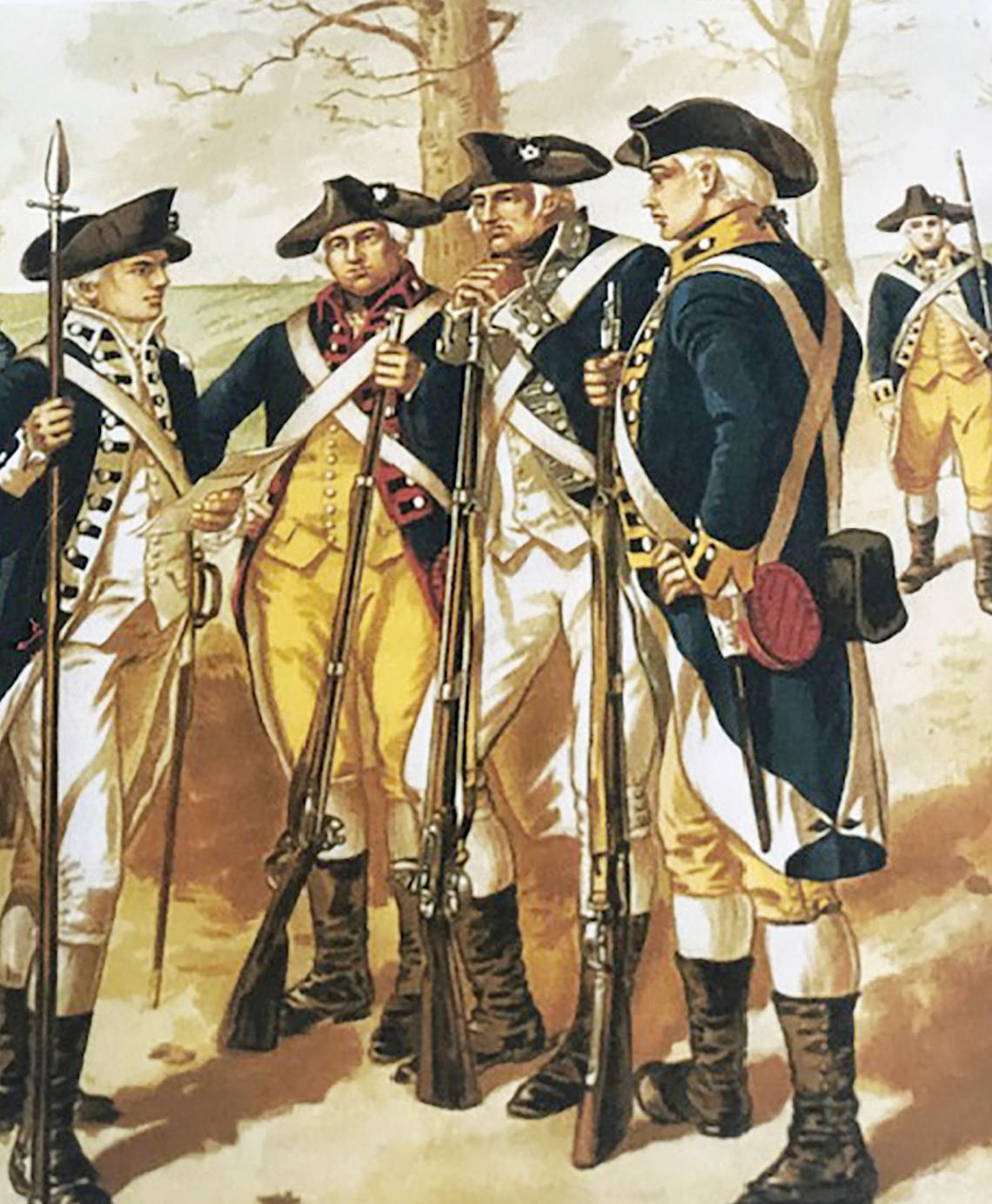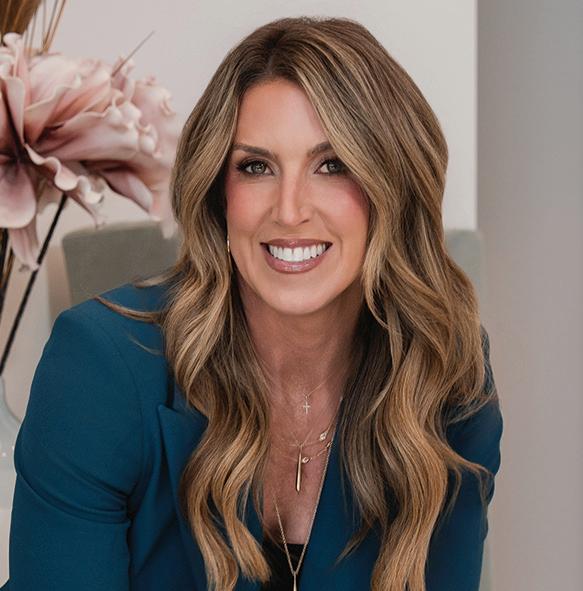

EAST HANOVER FLORHAM PARK
EAST HANOVER - On a quiet street in East Hanover, patriotism found its brightest ambassadors in two sisters, Aliya and Tia Nigro. Armed not with grand speeches or headlines, but with armfuls of small American flags and big hearts, they made their way door to door, offering a symbol of unity and gratitude to each neighbor they met. It started as a simple idea. With Independence Day around the corner, the sisters wanted to do more than watch fireworks light up the sky— they wanted to honor those whose service made those celebrations possible. Inspired by stories of veterans in their own family and community, they decided to bring their neighborhood together in a tapestry of stars and stripes. Each flag handed out proudly flew above the grave of the veteran. “Beneath every flag lies a story of courage; each one is flown in memory of a soul who served with honor,”
Aliya stated. Tia added, “We’re doing this to honor those who served and to celebrate the county we all share.” The reactions were moving—neighbors stepped outside to express thanks and share stories.
Before they knew it, the 3,000+ flags handed out made the neighborhood look like a miniature parade route! But more than the flags fluttering in the warm breeze, it was the spirit of community and remembrance that made the day unforgettable. Aliya and Tia didn’t set out to be heroes— they just wanted to make a difference, and in doing so, they reminded everyone that honoring veterans doesn’t always require a monument. Sometimes, it begins with a knock at the door and a simple gift held in young hands.
So when Aliya and Tia hand out flags, they’re not just honoring veterans—they’re stitching together a stronger, more connected neighborhood. In a time when unity can feel
scarce, the sisters’ effort is a gentle reminder that small acts of patriotism and kindness can ripple far and wide—one flag, one home, one heart at a time.
Tia Nigro is going to be a junior at Hanover Park High School this fall and plans on attending the share time program at Morris County Vocational School of Technology for the Culinary Arts. She chose to do this project to spread more patriotism and unity in our community, as well as show respect for the servicemen and women the flags represent and have had the honor to fly above their final resting place. “It was an honor to have done this, and I am so happy to see how many houses we were unable to get to put their own flags up. Unfortunately, we ran out of flags before we could get the entire neighborhood below Troy Road completed.”
Aliya Nigro is entering her senior year at Morris County Vocational School of Technology and will be attending

classes at CCM. She is currently in the Animal Science program and is striving to become a Veterinarian, a dream she has had since she was 3 years old. Aliya had seen her mother provide Veteran flags to her immediate street a couple of years ago but decided it should spread to the connecting streets as well. She and
Boy Scout Maps the Way For Hikers at Turkey Brook Park
BY CHERYL CONWAY STAFF WRITER
WEST ORANGE - Turkey
Brook Park in Budd Lake is on the map, attracting those living near and far—
And now with its five new kiosks, trail blazers and hikers will have directions, safety tips and useful information to guide them along their way.
Aiden Newman, 17, of West Orange, completed this project last month to earn his Eagle Scout merit badge with Troop 6 in West Orange. A member since 2021, Newman has been a Boy Scout since 2015. Led by his Scoutmaster Charles Coxe, Newman had seven scouts aged 15 to 18 help him with his project. He came up with the concept for his project from David Alexander, secretary of the Mt. Olive Twp. Open Space Advisory Board.
“My project was to assemble and deliver five trail kiosks for the Mt. Olive Trails Department to use for a new trail system,” explains Newman. “These kiosks could be used to display maps, safety bulletins and helpful information for hikers.”
A graduate of West Orange High Schol this past June,
Newman put in 17 hours to complete the project.
“I designed the concept with guidance from Mr. Alexander, bought the materials on June 11 and assembled my prototype on July 5,” details Newman. “Members of my Troop, parent leaders, my father and I, then assembled the remaining kiosks on July 13. We completed the final touches, delivered the kiosks, and installed one of them on July 16, completing the project.”
With multiple trails that outline and intertwine throughout the area, multiple kiosks are essential to help anyone navigate and find their way.
“My project aims to provide the Mt. Olive Trail Department an essential tool for hikers to use while navigating the new trails in Turkey Brook Park,” he explains. “I picked this project because I love hiking and getting outdoors, and I wanted a project related to hiking and woodworking. I hope these kiosks encourage and assist those looking to experience the trails in Turkey Brook Park.”
Those who helped Newman with his project included: Neil
Winner from July’s “Find Hank the Hornet Mascot” Contest
ata; Florham Park, Anthony F Monticello; East Hanover, Jen Jemas; East Hanover and Lucille Maccario; East Hanover. The ads that “Hank the Hornet” were in: Spicy Chef, Ideal Air, Minuteman Car Service, McKean monuments, Hancliffe Home for Funerals and Leaf Filter. Thanks to everyone who enter and congratulations to our winners!

and Eshe Newman (his parents), Charles and Ryan Coxe, Xavier and Johnny Kong, Akira Mura, Luke and JJ DelBello and Brian and Liam Coleman.
He spent approximately $800 out of pocket and he hopes to recoup some of those fund through his GoFundMe drive https://www.gofundme. com/f/support-aiden-newmans-eagle-scout-project
“It would be great to have support to finish funding the cost of sourcing the materials and to build any additional kiosks the trail may need this summer,” says Newman. “I also would like to encourage people to experience the trails and see the kiosks in person once they are all installed.”
From start to finish, Newman enjoyed the experience on working on this project and hopes its effort and value
stands the test of time.
“This project left me feeling accomplished and happy,” says Newman. “My project gave me the opportunity to spend time with my father, get closer to my troopmates, as well as contribute to getting people out to hike, something that I am passionate about.”
Looks like his project has mapped him to moving to his final rank as an Eagle Scout.
“Aiden is to be commended for planning, supervising and building five Trail Kiosks for our Mt. Olive Open Space trails,” says Alexander. “His leadership and volunteerism set a fine example and his pursuit of becoming an Eagle Scout is greatly admired. We look forward to him achieving the rank of Eagle Scout in the near future.”











Sisters Spread Patriotism and Honor, One Flag at a Time

her sister discussed how to do it and put the plan into action. Obtaining the flags from the cemetery, where they once flew over the graves of the military men and women, the sisters created a flyer with instructions and started bundling them for distribution. They were able to hand-distribute well over 3,000 flags to their neighborhood before running out. Aliya said of the experience, “My heart was full when we saw how many houses put the flags out. It was an amazing experience to have done and to see the result. I truly hope this is just the start of bringing honor and respect for our veterans and our flag.”


BY PETER NICOLAS GUEST WRITER
FLORHAM PARK - The Florham Park Rotary continued its proud support of the Florham Park Independence Day Parade for over 50 summers this year. Marching in the Parade is an enjoyable highlight of the club’s summer, waving to the happy residents lining the parade route as Rotarians carried the Rotary banner through the local streets. Near the Gazebo the Rotary sets up a 50/50 Scholarship raffle ticket tent by the Social Garden in the Family Picnic area. The raffle tickets sold on Independence Day are combined with the club’s other annual fund raisers. Those include the springtime “Taste of Florham Park” at the Vanderbilt Mansion (on the FDU
Florham Campus) and the autumn Halloween Dog Parade and Costume Contest on the Borough Hall Lawn by the Gazebo. The success of these three events has helped the club award $5,000 in scholarships this year to Florham Park students who have demonstrated community involvement. It reinforces Florham Park’s
Rotary 50/50 Raffle Ticket Tent with Rex Lyon, Bob & Nicki Feid in back row, with Simone Campbell and Betty O’Brien (in front row)
Rotarians marching with banner - Rich Tierney, Simone Campbell, Peter Nicolas, Doug Buttner
Florham Park Rotary Club Has New President
Diner.
success the Rotary these past few years and then fastening Dave with a Rotary President pin. Dave and his family are long time residents of Flor-
ham Park. Local residents and businesses also know him as a second-generation professional photographer. He recently transitioned his business from a brick and mortar location on Columbia Turnpike, to running it virtually in scheduling appointments to provide corporate portraits, take photos at social events and develop black & white editorials. He can be reached at 908-812-3225 or via email at DKramer88@gmail. com.
Dave joined the Rotary in
December 2023 while donating a gift under the club’s annual Angel Tree at the Florham Park Post Office. He eagerly participated in many club community projects while also being an active member of the Morris County Chamber of Commerce. He is very much looking forward to upcoming events. Those include the Rotary’s Halloween Dog Parade & Costume Contest scholarship fundraiser coming up this October, picking more than 500lbs of apples in November
to donate to the Interfaith Food Pantry, distributing dictionaries to Brooklake Elementary School Third Graders, and the many other club projects that benefit the surrounding community and Florham Park. He is also focused on growing the club’s membership. To learn more about the Florham Park Rotary, activities, and how you can participate, visit www.florhamparkrotary.org or email at info@ florhamarkrotary.org.

The Troubadour Acoustic Concert Series Presents Campfire Night at the Troubadour

AREA - Campfire Night at the Troubadour, August 15, 2025
Location of Event: Morristown Unitarian Fellowship 7:30 pm, $20.00 ($15 for members) features three outstanding performers, Sam Robbins, Ernie Sites, and Ken Galipeau, singing from the middle of a darkened audience, lit only by warm light of an electric campfire, with make-believe stars across the sky. The only amplified sound will be the croaking of frogs and chirping of crickets played softly in the background. S’mores and hot cocoa will be served. No bugs invited.
Sam Robbins is an internationally touring singer songwriter, in the vein of classic writers like James Taylor and Jackson Browne, with an upbeat side. He’s the 2021 Kerrville Folk Fest New Folk winner and he was the first to sing a Jim Croce song on The Voice. A western entertainer and an experienced cowboy, Ernie Sites. Among his many talents, he is a western performer, songwriter, cowboy poet, trick roper, bull rider, rodeo clown, bareback rider, team roper and a calf roper. He has traveled the world over, using his gifts to teach people about cowboys and the west.
Contagious energy, sincere enthusiasm, and an eclectic repertoire make Ken Galipeau a singer and storyteller unlike any other. Drawing from both time-tested tradition and his own experiences, Ken’s songs
will touch your heart and tease your soul.
The Troubadour Acoustic Concert Series Presents Dead on Live, August 22, 2025, Location of Event: Morristown Unitarian Fellowship, 7:30 pm, $20.00 ($15 for members) Multi-instrumentalist Marc Muller directs a note-for-note celebration capturing important and beloved periods of the Grateful Dead’s long, illustrious, and stylistically diverse career. He has assembled an impressive cast of world class musicians who have been able to reproduce virtually every note of every instrument, as well as all of the beautifully orchestrated vocal arrangements, that are trademarks of the Dead’s classic American recordings, to a level that’s perhaps never been accomplished and performed live in concert before. In keeping with the true spirit of the Grateful Dead, every Dead on Live show also features plenty of jamming and improv.
The Troubadour Acoustic Concert Series Presents Christie Lenée and Kenny White, August 29, 2025, Morristown Unitarian Fellowship, 7:30 pm, $20.00 ($15 for members)
Christie Lenée—Acoustic Guitarist of the Year and one of Guitar World’s “Best Acoustic Guitarists in the World Right Now”—delivers a concert experience that’s as technically dazzling as it is
emotionally uplifting. Called “a firecracker [on] a high-wire circus routine” (Guitar Player Magazine), Lenée mixes fingerstyles, two-hand tapping, and improvised percussion to push the limits of acoustic performance. Her shows radiate joy, and celebrate life and love. Her compositions are epic — almost symphonic in their lush and effortless execution.
Kenny White is the consummate entertainer, an extraordinary pianist, poet, and master storyteller. Praised as “Mark Twain with a piano” and renowned for touring with Judy Collins and Stephen Stills, Kenny brings his razor-sharp lyrics, rich musical history, and electric stage presence to the Troubadour. With a career spanning hits with Peter Wolf, film soundtracks, and iconic ad jingles, Kenny now shines center stage. The Troubadour Acoustic Concert Series Presents Alice Howe & Freebo and Bill Hall with Scott Nelson, September 5, 2025, Morristown Unitarian Fellowship, 7:30 pm $20.00 ($15 for members)
Alice Howe & Freebo have undeniable chemistry. Rock bass legend Freebo weaves his fretless stylings into Alice’s soulful, impeccably tuned vocals for a harmony-driven performance showcasing two uniquely compelling songwriters. Their latest album Alice Howe & Freebo Live is their first release as a duo, and it de-






buted as the #1 Most Played Album on the Folk Radio Chart. William J. Hall is a songwriter’s songwriter and a poet’s poet. This almost-legendary North Jersey artist and Kerrville New Folk award-winner is emerging from the shadows for a rare and precious performance that will be recorded live for his next album. Bill is a master at his craft, and he inspires standing ovations for his insightful, universal love songs, his luscious musical landscapes, and his fascinating snapshots of life. Bill has performed with David Amram, Norman and Nancy Blake, Dave Bromberg, Allan Ginsberg, John Hartford, Don Mc-




The Folk Project is New Jersey’s leading acoustic music and dance organization, and has been showcasing acoustic and traditional music in North Jersey since 1971.
Funding has been made possible in part by funds from Morris Arts through the New Jersey State Council on the Arts/Department of State, a Partner Agency of the National Endowment for the Arts. Contact Information: The Folk Project: troubadour.folkproject.org
Clean, Melanie, Harry Nielson, Tom Paxton, Pete Seeger, Jackie Tice, Suzanne Vega, Robin Williamson, and Peter Yarrow. Scott Nelson is more than an accomplished bass guitarist with exquisite taste and gifted ear. He earned historic respect and love from the Folk Project as founding member of Frostwater, the fabulous acoustic band featuring Bill Hall and Project founder Lauren Reilly. These concerts are part of The Troubadour Acoustic Concert Series, now in its 50th year, sponsored by The Folk Project each Friday evening at the Morristown Unitarian Universalist Fellowship. For further information, call 201-6506928, or visit www.folkproject. org. The Folk Project website offers music samples of Troubadour performers at troubadour.folkproject.org.







Dave Kramer receiving Rotary president pin from Simone Campbell.
Alice Howe & Freebo





















NJ Gov. Candidate Jack Ciattarelli Meets with Jewish Community Leaders, Discusses Education, Security & Rising Antisemitism

AREA
sit-down with Jewish community leaders since winning the Republican gubernatorial primary, Jack Ciattarelli visited the Rabbinical College of America’s Morristown campus on Friday, July 11, engaging in a 90-minute discussion with Chabad rabbis representing communities from across New Jersey about pressing issues facing the state’s Jewish communities.
The visit brought together Chabad rabbis from the movement’s 72 centers statewide, representing the largest Jewish organizational footprint in New Jersey. The discussion focused on education policy, security concerns, and the rising tide of antisemitism affecting Jewish communities throughout the Garden State.
“This visit displays true concern for the needs of New Jersey’s large Jewish commu-
nity,” said Rabbi Mendy Herson, Dean of the Rabbinical College of America and Director of Chabad of New Jersey, who hosted the discussion alongside Senator Anthony Bucco and philanthropist Amir Hadar.
During the visit, Ciattarelli also addressed 288 fourteenyear-old students from countries including Brazil, Chile, Dominican Republic, and Russia, who are participating in the institution’s Yeshiva Summer Program (YSP). The international students are in Morristown as part of their transition from eighth grade into the yeshiva high school system.
Rabbi Herson introduced Ciattarelli to the students, emphasizing the importance of civic engagement and quoting the Mishnah’s teaching to “pray for the welfare of government,” a principle central to
Jewish civic participation.
“I have deep ties in the Jewish community and serious concerns about the issues facing the community,” Ciattarelli told the gathering. “I chose to make my first visit with the Jewish community here at Chabad because of their extensive footprint across New Jersey – they’re in every corner of our state, serving Jews from all walks of life.” He also announced his upcoming trip to Israel.
The visit included participation from prominent Chabad leaders including Rabbi Eli Kornfeld (Chabad of Hunterdon County), Rabbi Avi Richler (Chabad Liaison of Political Affairs), and rabbis from communities spanning the entire state. Ciattarelli has maintained decades-long relationships with several of these leaders, particularly Rabbis
Kornfeld and Richler.
Senator Anthony Bucco, whose family has enjoyed warm relations with the Rabbinical College of America spanning two generations, posted after the visit: “Always enjoy visiting my friends at the Rabbinical College of America.”
The Chabad movement, known for its philosophy of reaching Jews of all levels of
observance with love and acceptance, operates 72 centers across New Jersey staffed by 92 rabbinical couples, representing the state’s most extensive Jewish communal infrastructure.
While the Rabbinical College of America welcomes visits and discussions with all candidates and does not endorse candidates for office, the timing of this visit – as Ciattarelli’s
first major Jewish community engagement following his primary victory – signals the importance of Jewish voters in the upcoming gubernatorial race.
The college noted that while Democratic candidate Mikie Sherrill has not yet reached out for a similar meeting, they remain open to hosting discussions with all gubernatorial candidates.




























































Ciattarelli addresses 288 international students alongside Rabbi Mendy Herson







I Remember Dad: A Most Endearing Gift

BY RICHARD MABEY
GUEST WRITER
AREA - In September of 1969, I turned 16 and began my junior year at Boonton High School. It was late September that a most traumatic event came to my life. I got a “D” on a chemistry quiz. It was the first “D” I had ever received in my life. I was deeply hurt and thought that my unbroken yield of continuing to make the Honor Roll, had come to a grinding halt.
That very night, I confessed to my father about getting a grade of “D” on my first chemistry quiz. I was very embarrassed and felt ashamed. To my surprise, my father was not upset at all. The main thing that he told me was that I needed to study my chemistry, even more. It was just that simple.
The weekend that followed, Dad and I took a ride to a little bookstore in Wayne. Dad bought me a booklet titled, “The How and Why of Chemistry.” This booklet presented the subject of chemistry in a much more understandable style than my textbook did. I read this book, from cover to
cover, that weekend.
When we got home from the bookstore, that Saturday morning, Dad and I sat down at the dining room table of the old Mabey Homestead. Dad worked on scouting paperwork, which was part of his volunteer job of serving as Scoutmaster of Boy Scout Troop 170. I remember that Dad and I spent that entire Saturday afternoon and evening sitting at the dining room table.
Dad did not know much about chemistry. But he knew that if I was going to get a good grade on my next chemistry quiz, I needed to study more than I had been studying. So, after church that following Sunday, once again, Dad and I began sharing the dining room table.
I remember that Mr. Toomey, my chemistry teacher, gave us another chemistry quiz that following week. To my amazement, I got a “B” on that quiz.
I owe the sun and the moon and the stars to my father. He believed in me, more than I believed in myself. He would




never let me give up. He would never allow me accept defeat. My father had a rare blend of being both caring and stern with me. Now at 71, nearly 20 years have passed since my beloved father went Home to be with the Lord. I still miss him very much. A day hasn’t gone by that I haven’t thought about him. My father built a foundation in my heart and soul, that was filled with inner strength and determination. He taught me to never give up, to never ever give up.
If you’re a parent, the most wonderful gift that you can give to your child, is to teach him or her to believe in themself, to never give up, to never surrender when things get tough. For truly, love is the most powerful force in the universe. Richard Mabey Jr. is a freelance writer. He has recently had two books published. He currently hosts a YouTube Channel entitled, “Richard Mabey Presents.” Richard may be contacted at richardmabeyjr@gmail.com.





From the Autumn of 1969, Dad and I studying at the dining room table of the old Mabey Homestead.
JR.
BY HENRY M. HOLDEN STAFF WRITER
AREA - These days we are locked in a national debate about whether women should have the right to obtain abortions. In the late nineteenth and early 20th century, the women of New Jersey were debating a different question. Should women vote?
In July 1848, Elizabeth Cady Stanton and Lucretia Mott organized the first Women’s Rights Convention in Seneca Falls, NY. The Convention produced a list of demands called the Declaration of Sentiments. It was modeled on the Declaration of Independence; it called for broader educational and professional opportunities for women and the right of married women to control their wages and property. After this historic gathering, women’s voting rights became a central issue in the emerging debate about women’s rights in the United States.
Many of the attendees at the convention were also abolitionists whose goals included universal suffrage and the right to vote for all adults. In 1870, this goal was partially realized when the 15th amendment, granted black men the right to vote, was ratified. Woman suffragists’ were in vehement disagreement over supporting the 15th Amendment. However, it resulted in a “break” that split the women’s suffrage movement into two new suffrage organizations that focused on different strategies to win women voting rights.
During the 1850s, the women’s rights movement gathered steam, but lost momentum when the Civil War began. Soon after the war ended, the 14th Amendment and the 15th Amendment to the Constitution raised familiar questions of suffrage and citizenship. The women’s suffrage movement made the question of women’s voting rights into an important political issue in the 19th century. Not everyone followed the same path in fighting for women’s equal access to the vote, and the history of the suffrage movement is one of illogical as well as collaboration.
The suffragist used two arguments: First, they said that because women constituted half the population, simple justice demanded that they have the right to vote. How unfair it would be if women were classified with criminals or the
Women’s Suffrage – 100 years to Victory
mentally ill and being denied the vote. Second, they predicted that giving women the vote would usher in a better world.
The more extreme advocates claimed that women would abolish war, alcoholism and political corruption.
A woman who signed XX wrote to the Newark Evening News seems to have expressed the anxieties of many of her sisters. “Women are not prepared for the anxieties of many of her sisters and are not prepared for a women’s suffrage amendment, neither do they want the vote. Over ten percent of the women in this glorious state are dissatisfied with the men of our state and our country on what they did for us in the past. That ten percent are striving to plunge ninety percent of contented women into the political arena regardless their efficacy, their preparedness, or their desire.”
The suffragists split into two organizations. Susan B. Anthony, and Elizabeth Cady Stanton formed the National Woman Suffrage Association (NWSA). The primary goal of the organization was to achieve voting rights for women by means of an amendment to the U.S. Constitution. Lucy Stone, Henry Blackwell, and others formed the American Woman Suffrage Association (ASWA), which focuses exclusively on gaining voting rights for women through the individual states.
Susan B. Anthony and Matilda Joslyn Gage decided to change the dynamic and disrupted the official U.S. Centennial program at Independence Hall, in Philadelphia, presenting a “Declaration of Rights for Women.”
Anthony registered and voted for Ulysses S. Grant in the presidential election in New York. She was arrested, tried, and convicted in 1873. Her defense, that the Equal Protection Clause of the 14th Amendment entitled her to vote, was unsuccessful.
The 15th Amendment (1869) to the U.S. Constitution read: “The right of citizens of the United States to vote shall not be denied or abridged by the United States or by any State on account of race, color, or previous condition of servitude. Note, the gender issue never arose.
In the year following the ratification of the 15th amendment, the NWSA sent a voting

rights petition to the Senate and House of Representatives requesting that suffrage rights be extended to women and that women be granted the privilege of being heard on the floor of Congress.
Resentment toward the status quo had been building and an anti-Suffrage Party was organized in 1870. Many people, including prominent women, such as Ellen Sherman, wife of General William Tecumseh Sherman, challenged the notion of suffrage as a “natural right,” and opposed its extension to women. In their view, women’s political participation threatened their significant roles as wives, mothers, and educators.
The second national suffrage organization was the American Woman Suffrage Association (AWSA), founded by Lucy Stone, and Julia Ward Howe. The AWSA supported the 15th Amendment and protested the confrontational tactics of the NWSA. The AWSA concentrated on gaining women’s access to the polls at state and local levels, in the belief that victories there would gradually build support for national action on the issue.
The National Association of Black Women was formed 1880s with the goal of achieving equality for women of color. The association brought together more than 100 black women’s clubs.
A growing number of Black Women actively supported women’s suffrage during this period. They organized women’s clubs across the country to advocate for suffrage, among other reforms. Prominent African American suffragists included Ida B. Wells-Barnett of Chicago, a leading crusader against lynching; Mary Church Terrell, educator and first president of the National Association of Black Women; and Adella Hunt Logan, Tuskegee Institute faculty member, who insisted in articles in The Crisis, a publication of the National Association for the Advancement of Colored People (NAACP), that if white women needed the vote to protect their rights, then black women – victims of racism as well as sexism – needed the ballot even more.
While a federal woman suffrage amendment was not their priority, an 1871 petition, asking that women in District of Columbia and the territories be
allowed to vote and hold office, from AWSA leadership to Congress revealed its support for one.
In 1890, the NWSA and AWSA merged into the National American Woman Suffrage Association. It became the largest woman suffrage organization in the country and led much of the struggle for the vote.
In 1919, a year before women gained the right to vote with the adoption of the 19th amendment, the NAWSA reorganized into the League of Women Voters.
The suffragists knew the current tactics would have to go beyond petitions and memorials to Congress.
Testing another strategy, Susan B. Anthony registered and voted in the 1872 election in Rochester, NY. As planned, she was arrested for “knowingly, wrongfully and unlawfully voting for a representative to the Congress of the United States.”
She was convicted by the State of New York and fined $100, which she insisted she would never pay. On January 12, 1874, Anthony petitioned Congress, requesting “that the fine imposed upon your petitioner be remitted, as an expression of the sense of this high tribunal that her conviction was unjust.”
Wealthy white women were not the only supporters of women’s suffrage. Frederick Douglass, formerly enslaved and leader of the abolition movement, was also an advocate. He attended the Seneca Falls Convention in 1848.
In the second decade of the 20th century, suffragists began staging large and dramatic parades to draw attention to their cause. One of the most consequential demonstrations was a march held in Washington, DC, on March 3, 1913. Though controversial because the march organizers’ attempt to exclude, then segregate women of color, more than 5,000 suffragists from around the country paraded down Pennsylvania Avenue from the U.S. Capitol to the Treasury Building.
Many of the women who had been active in the suffrage movement in the 1860s and 1870s continued their involvement over 50 years later. In 1917, Mary O. Stevens, secretary and press correspondent of the Association of Army Nurses of the Civil War, asked the chairman of the House Judicia-

ry Committee to help the cause of woman suffrage by explaining: “My father trained me in my childhood days to expect this right. I have given my help to the agitation and worked for its coming a good many years.”
Notably, the NWP organized the first White House picket in U.S. history on January 10, 1917. They stood vigil at the White House, demonstrating in silence six days a week for nearly three years. The “Silent Sentinels” let their banners – comparing the President to Kaiser Wilhelm II of Germany – speak for them. Many of the sentinels were arrested and jailed in deplorable conditions. Some incarcerated women went on hunger strikes and endured forced feedings. The Sentinels’ treatment gained greater sympathy for women’s suffrage, and the courts later dismissed all charges against them.
When New York adopted woman suffrage in 1917 and President Woodrow Wilson changed his position to support an amendment in 1918, the political balance shifted in favor of the vote for women. There was still strong opposition to enfranchising women, however, as illustrated by petitions from anti-suffrage groups.
On October 19, 1915, the men of New Jersey voted in a referendum on a proposed amendment to the state constitution which would give wom-



en the ballot. The move was unsuccessful, and women did not win the referendum.
But within four years women were 0n the ballot, again. Eventually suffragists won the political support necessary for the ratification of the 19thAmendment. For 42 years, the measure had been introduced at every session of Congress but ignored or voted down. It finally passed Congress in 1919 and went to the states for ratification. In May, the House of Representatives passed it by a vote of 304 to 90; two weeks later, the Senate approved it 56 to 25. Those against the amendment managed to delay official ratification. Anti-suffrage legislators fled the state to avoid a quorum, and their associates held massive anti-suffrage rallies and attempted to convince pro-suffrage legislators to oppose ratification. However, Tennessee delivered the crucial 36th ratification necessary for final adoption. While decades of struggle to include African Americans and other minority women in the promise of voting rights remained, the face of the American electorate had changed forever.
August 26, 2020, marked the 100th anniversary of when the federal government certified states’ ratification of the 19th amendment pertaining to voting rights for women.

BY HENRY M. HOLDEN
AREA - It was a time when American colonist began to feel crushed with heavy and illegal taxes. Imposed by England. They felt that the heavy tax imposed on tea was illegal without physical representation in Parlement. It was unfortunate that the colonists, under the rule of Great Britain, had no means of voicing their grievances and there were 12 other colonies (States) that felt the same way.
The business of forcing tea on the American colonies had become a very serious matter. Tea was a major trading commodity, and the warehouses in London stored approximately 17 million pounds of tea. If there should be no sale to any of the American markets the outcome would be catastrophic for England. In the pre-revolutionary war days liberty was a much wanted and needed commodity
New Jersey Tea Party
for the future United States of America. The colonist of New Jersey showed a strong desire for independence. Many were hopeful that the spirit that welcomed Philadelphia would also welcome the spirit in the hopeful and thriving inhabitants in Cumberland County. Founded in 1675 by John Fenwick, Cumberland County, New Jersey, is older than Philadelphia, which was not founded until 1682. The hands of time had not touched Greenwich. It is much the same today as it was three hundred years ago, except the British flag is no longer flying; instead it is the stars and stripes of 50 United States of America, that are no longer Colonies.
Boston Tea Party, (December 16, 1773), was an event in which 342 cases of tea belonging to the British East India Company were thrown from ships into Boston Harbor by

American patriots disguised as Mohawk Indians. The Americans were protesting both a tax on tea (taxation without representation) and the monopoly of the East India Company. The events of that day would later spark a copycat action.
Tea from England was sent to the ports of Boston, New York, Philadelphia and Charleston; and what tea was used in New Jersey came from those places after the consignees had paid the tax.
The passage of the Tea Act (1773) by the British Parliament gave the East India Company exclusive rights to transport tea to the colonies and empowered it to undercut all its competitors. The leaders of the major cities in the colonies cancelled their orders in protest, but the governor of the Massachusetts Bay Colony allowed tea to arrive in Boston.
On the evening of, December 22, 1774, a company of about forty young Whigs, (taking a page from the Boston Tea Party a year earlier) disguised as Indians, entered the cellar, of Dan Bowen’s house. Having found an English sympathizer, a Tory, as they were called, Daniel Bowen, allowed the Greyhound’s crew secretly stored the cargo of tea in the cellar of his home.
They took possession of the entire cargo of tea, transferred the tea cases from the cellar into an adjoining field, and piling them together, burned them in one general conflagration.

thirty-five was later appointed, with representatives from Greenwich, Deerfield, Jericho, Shiloh, Bridgeton, Fairfield and perhaps other places.
tent by reacting to oppressive governmental measures. They had clearly taken a stand for independence and democracy.
News of the Boston Tea Party had reached Greenwich, and the defiant example was regarded by many of the local settlers as worthy of their own contempt for the British. Fate now presented them with a ready-made opportunity to duplicate the act.
The Tea company was undoubtedly under the impression that the conservative feelings and principles of the people of New Jersey would induce them to submit quietly to a new tax. The result showed that the temper of the people was little understood by the East India Tea Company.
However, this unusual procedure was noted by the citizens who immediately appointed a temporary committee of five to look after the matter until a county committee might be appointed.
A general committee of
On the evening of, December 22, 1774, a company of about forty young Whigs, disguised as Mohawk Indians, entered the cellar of Bowen’s house. They took possession of the cargo and moved the tea chests from the cellar into an adjoining field, and piled them and together, burned them in one general conflagration.
Later, several participants in the Tea Party were brought up on charges by the representatives of the Crown. A call to every adult person for funds to help those under charges resulted in raising thousands for legal fees. However, there was never a trial because the issue was moot. The shooting war with the British had already begun.
Thus, the patriots of Cumberland County living in Greenwich expressed their discon-
Today, Greenwich has been granted the distinction of being one of the five tea-party towns in America, the others being Charleston, Annapolis, Princeton, and Boston. In 1908 a monument was erected to remember the original old marketplace on Ye Greate Street where the burning of a cargo of British tea first took place, on December 22, 1773.
Be It Ever So True: Kindness Is More Precious Than Gold
BY RICHARD MABEY JR. GUEST WRITER




and Lou,



In the early winter of 1774, the quiet residents along the banks of the creek were startled by the appearance of a British brig, (a sailing ship with two masts), called the “Greyhound,” by its captain. It avoided sailing to Philadelphia and sailed about four miles up the Cohansey Creek. The brig stopped at the village of Greenwich, which was its first landing laden with a cargo of tea sent out by the East India Tea Company. The little town of Greenwich, about forty miles from Philadelphia was the principal settlement of Cumberland County in 1774.
Meanwhile, the captain of the “Greyhound” vessel carrying tea realized that his vessel would be seized by the British and he would have to pay a heavy tax on the tea. So, he diverted course from Philadelphia and headed up the Cohansey Creek, a navigable body of water running through Cumberland County and emptying into Delaware Bay.

AREA - I grew up in the small town of Lincoln Park, New Jersey. I was raised in the very home that my great grandfather, William Mabey Jr., built in 1890. My paternal grandparents, Watson and Bertha Mabey, lived with my mom, dad, sister and I. There were certain values that were prevalent in small town life, growing up in the 1950’s. Now at 71, I am not so sure they are out of style, nor not in alignment with our modern world.
Having been fairly recently diagnosed with the very serious heart disease of Hypertrophic Cardiomyopathy, I do my utmost best to keep my thoughts positive and filled with loving energy. The other day, I reflected upon a simple act of kindness that my dear Grandpa Mabey practiced with great regularity.
In the backyard of the old Mabey Homestead, there once stood six grand and glorious apple trees. I remember, in the summer months, Grandpa and I would pick up all the apples that graced the green grass. We would put them in old pails and

buckets, then walk to the forest path at the end of Mabey Lane.
Grandpa and I would walk the forest path together, carrying our pails of fallen apples. Every so often, Grandpa and I would stop along the wooded trail and I would follow Grandpa’s lead. We would spill out a few apples from one of our pails and then move on. We would walk the forest trail for a short while, then stop again and spill out some apples along the edge of the path. There was a reason why Grandpa taught me to spill apples along the wooded trail that led to the towpath of the old Morris Canal. I remember it all so well, like it was yesterday. Grandpa would say to me,
with wisdom filling his voice, “Richie Jim we’re leaving dessert for the deer of the forest.” Grandpa’s face would light up as he smiled his crooked grin. Grandpa truly loved the wild creatures of the forest. Now, over 60 years later, I reflect upon dear old Grandpa’s kindness and it brings warmth and joy to my heart. Kindness is so ever incredibly precious. Truly, kind acts are more precious than gold. Richard Mabey Jr. is a freelance writer. He has recently had two books published. He currently hosts a YouTube Channel entitled, “Richard Mabey Presents.” Richard may be contacted at richardmabeyjr@gmail.com.


Dear old Grandpa Mabey, standing at the end of Mabey Lane. Please note Grandpa’s garage in the right hand side of the picture. To the best of my knowledge, Grandpa’s garage is still standing.

NJStarz
NJ Starz: Ashley Umberger
Hometown: Jefferson Township
BY EVAN WECHMAN
STAFF WRITER
AREA - Persistence is a trait
Ashley Umberger is familiar with. For Umberger of Jefferson Township, NJ, and the current owner of Boonton’s North Star Gymastics, she has been exemplifying this trait her whole life.
Her journey from a child gymnast to competing internationally on the U.S. National Gymnastics team and getting a scholarship at the University of Georgia is a great story of perseverance. However, it doesn’t end there as Umberger found after graduating college that her true passion was coaching other gymnasts in Boonton.
Umberger easily recalls her start in the sport when she was just a toddler, and how her parents’ dedication helped her succeed.
“My parents put me in gymnastics classes when I was four years old.,” Umberger said. “I grew up in the Poconos and started gymnastics at International Gymnastics School. And I stayed there for a while, and they didn’t have a competitive team, but they were the ones that really said, ‘Hey, she’s quite talented. You should take her somewhere.’ I did go to another gym in Pennsylvania for a little while, and then that just wasn’t a right fit. And then at the age of nine years old, I started commuting to North Stars in New Jersey, which was about an hour and 15-minute drive. I started doing that, and eventually I was homeschooled because the amount of drive time that it took, it just wasn’t feasible to do school and then go to the gym and come back and survive that.”
Umberger remembers sitting in the car with her parents stalled in traffic on I-80, but realizes it was all for the best. Her mom and dad never put undue pressure on her, but she felt some anxiety as a child competitor who was advancing quickly in the sport. However, she learned to control her emotions through great coaches at North Star as a student and is now able to incorporate those skills into her coaching today.
“I think any competitor feels pressure from an inside point, because you want to do well,” Umberger said.” You feel like you dedicated a lot of time, and you have to really work with your coach, and your coach has to be inside your head a little bit. You have to do enough routines. And so, what we say, is it’s just another routine, the one that you just completed, can’t matter more than the next one because you’ll mess it up. It just has to be as we say, ‘trust the process.’ So, when your hands go up, you got to trust the process, trust that you’ve done the numbers. And you just have to breathe and just do another routine. So, it’s easier said than done, obviously, And, you know, it happens through a lot of failing and then learning how to control it.”
However, despite Umberger’s ability to communicate tremendously with her young students, the opportunity of becoming a great coach almost passed her by. As she excelled as a student at North Stars gymnastics and then both on the National and collegiate lev-
el, it almost didn’t occur to her that she would make a terrific coach.
After graduating the University of Georgia with a degree in speech communication, she entered the insurance industry hoping to find happiness. In retrospect, Umberger realizes she may have been preparing for coaching the whole time.
“I never knew I wanted to be a coach but at this point in time, I can say I was training for it my whole life. I graduated college and tried to use my degree and went to work for Mass Mutual, and worked my sales job there, and then found myself bored at night and started working part time in the gym. And then I started looking forward to going to the gym more and more at night, versus my desk job, and I sort of just fell back into wanting to coach gymnastics. So, I came back home from Georgia, and I coached at a gym, and met my husband in Hershey, and then I moved back over to New Jersey in 2013,” Umberger said.
Umberger has not looked back since that time. Now, as one of the owners of the gym and the head coach of the elite squad, she has helped many young teenage athletes get scholarships into nationally renowned universities. Her goal every year is to help her all her graduating seniors get athletic scholarships to their dream schools, and she has been very successful in achieving this goal.
In addition, North Stars has had medalists at the USA Championships, Goodwill
Games, Pan American Games, Pacific Alliance Championships as wells as competitions in France, South Korea, England, Russia, Bulgaria, Colombia, Brazil, Jamaica, China, Canada, Puerto Rico, Bahamas, Cuba, U.S. Olympic Trials and more.
Though this is quite an impressive record, Umberger remains modest. She credits her success as a coach to her time mostly as a young student gymnast at North Stars.
“I had really good coaching, like Tony and Paul (her coaches at North Stars) who were very logical in how they taught the basics such as conditioning and discipline, and I had to learn the skills,” Umberger said.
“You have to do all the numbers. I was not a very natural athlete. I had to work hard. But at least they had the education. And so through me having to learn all the drills from step a to step B. It naturally became ingrained to me of how skills are taught. And then I went to college, and I had a combination of some good coaches and some ones that I butt heads with a little bit, and then It was figuring out that I really knew how to talk to kids and relate to them and get through to them. From there, you can change things.
Umberger, since 2013 has helped establish North Stars as a preeminent gymnastics’ academy in the Northeast. Besides helping to ensure her students go to top international competitions and attend great universities, she has earned a reputation in the area as a terrific commu-

nicator and coach. For instance, none other than professional football star, Saquon Barkley of the Philadelphia Eagles reached out to her a little over a year ago for assistance.
“Last year, we trained on the weekends, Sunday or Saturday from 7:30-9:30, when the Giants released him and he was going to the Eagles. Last summer, we probably had like five or six training sessions. He had an ACL tear years ago, so he wanted to work that coordination, and many NFL players are doing gymnastics training in the offseason to learn how to fall when they get hit. That jump he did over that guy in that game, we did pike jumps backwards on the tumble track toac work his height,” Umberger said.
As North Stars Gymnastics, who celebrated their 50th anniversary in 2023, marches forward under the leadership of Umberger, the school and its staff know they are in great hands. Umberger, a skilled
gymnast and teacher realizes this is her calling and acknowledges she is here for the long term.
She embraces the challenge of working with young gymnasts and understands it ultimately comes down to relationships.
‘So, I think there’s a human aspect of it that is a big part of what we do, really involving the athlete, letting them have something to say, because it’s their bodies doing the flip. It’s their bodies doing the work, you know. So they have to be comfortable. They have to know we’re going to push them. It’s going to be hard, but ultimately, it’s a dual road between the coach andt the athlete,” Umberger said. The coach knows this is a difficult process but loves the bonds she has formed.
“The emotions of being a head coach and dealing with it all is hard, but due to my tenacity, I still have that love and determination and am enjoying it all.”
A Warrior’s Story: The Life and Legacy of Jamie Smith
BY MEGAN ROCHE STAFF WRITER
AREA - In A Warrior’s Story, you’ll meet and learn about all the sides of Jamie Smith. Smith was a West Morris Central (WMC) High School graduate who paid the ultimate sacrifice while serving as a US Army Ranger during the Battle of Mogadishu in 1993. You’ll hear from Jamie’s former teachers, his Army Ranger battle buddies, and how his legacy still lives on to this day in the halls of WMC. This series will be an on-going feature in the months ahead.
While current students at the school may not have walked the halls with Jamie, that doesn’t stop teachers and staff from ed-
ucating the next generation of the Wolfpack family about his heroic efforts.
In 2019, during ‘A Call to Courage’ week, history and English classes focused a lesson on learning about Corporal Jamie Smith and his life and service. Clubs got involved at the school as well, with Film Club screening Black Hawk Down (a movie that was inspired by Smith’s last battle). Veterans were also invited to a roundtable discussing with students during the lunch period on Oct. 2 to give them a chance to ask any and all questions about their service. On Oct. 4 of that year a school wide assembly

was held.
For Principal Tim Rymer, this assembly was a chance to extend the notion to the community that all those who walk the halls of West Morris Central are remembered, regardless of what activities they were involved in, if they were athletic, artistic, academically driven, etc.
“Leading up to our big celebration on Oct. 4, we wanted to make sure every student and every staff member knew who Jamie Smith was. We had a big school wide assembly where we had a keynote speaker, Debbie Gonzales, who was Jamie Smith’s English teacher while

best value in transportation
he was a student at West Morris and she also spoke the eulogy at Jamie’s funeral. Corporal Smith’s brothers and sister were also present to honor their brother’s life.” Rymer said.
That event in 2019 has led to an annual civics day where freshman learn about Smith and the legacy that he left behind. Phil Nicolosi and Christian Hildreth, two history teachers at the school, work to plan the civics day event each fall.
“We realized that these kids had no context for who Jamie was and no context as to why he was in Somalia. We decided to set up his legacy, we really had to talk about the Battle for


Mogadishu. We talked about the concepts behind courage and bravery, and how people are remembered. That transitioned into a brief discussion around Somalia and what led to the Battle,” Hildreth shared.
To make things even more real for the students, Hildreth and Nicolosi teamed up with Barry Buchanan, fellow WMC teacher, who was given the first ever Jamie Smith Award shortly after his passing.
For Nicolosi, to help preserve Jamie’s legacy, is incredibly important.
“Jamie Smith is just like them. He comes from their town. He sat in the same desks
that they do. I always try to drive that point home to the kids. It’s the idea that Jamie embodied courage and bravery in his everyday life. One of the big things for me, I’ve been here for a long time and you never know if there is another Jamie Smith sitting in that group of kids that is sitting right in front of you. Jamie is a history maker and we want his story to be a point of inspiration,” Nicolosi said. A Warrior’s Story: The Life and Legacy of Jamie Smith will continue in the September 2025 issue, where you’ll learn how Smith’s legacy became recognized in the State of New Jersey.


Umberger is pictured with former North Stars Gymnastics Academy gymnast Alana Walker, who competed for the Jamaican National Team in June 2021 at the Junior Pan American Championship in Guadalajara, Mexico. Walker won the bronze all-around, marking the first Jamaican to win a medal in gymnastics at an international competition. Today, Walker still competes for Jamaica and for Stanford University.
BY DANA JACKSON
Q:Is it true that the new Mrs. Bezos used to be an actress? What has she been in? Also, did his ex-wife ever remarry? -- K.D.
A:Yes, Lauren Sanchez, who is newly wedded to Amazon billionaire Jeff Bezos, has an IMDb page of acting credits, but most of her roles consist of playing reporters and news anchors. Before this, she majored in communications at the University of Southern California, which is why she was probably a natural for these types of roles. Her first on-camera role as a reporter or anchor was in 1997 in the series “Babylon 5,” followed by the cult classic film “Fight Club.”
Many people probably don’t remember that she was the original host of the reality competition series “So You Think You Can Dance,” which premiered in the United States in 2005. She left after one season to have
BY DEMI TAVERAS
Celebrity Extra Couch Theater ENTERTAINMENT
“Lilo & Stitch” (PG) -- The 2002 animated film “Lilo & Stitch” was such a hit for Disney that it spawned several sequels and spin-off series. Now, 23 years later, Disney produced a live-action remake of the original “Lilo & Stitch” story, with Chris Sanders reprising his role as Stitch and 8-year-old Hawaiian native Maia Kealoha playing Lilo. Forget about it just being a hit; this live-action film smashed box-office records for Memorial Day weekend and grossed more than $1 billion! Of course, this means that a sequel for the film is already in development. But before we get too ahead of ourselves, make sure to check out this live-action film for your-
a baby and was replaced by Cat Deeley. Bezos’ ex-wife MacKenzie Scott, who played a significant role in the early rise of Amazon, remarried in 2021 to a science teacher. Unfortunately, it didn’t last, and she filed for divorce a year later.
According to USA Today, as part of her divorce settlement from Bezos, Scott planned to donate half of her wealth to charity, and she has. The Center for Effective Philanthropy released a study in February stating that her donations have totaled $19.25 billion and have been distributed to over 2,450 nonprofit organizations.
***
Q:Will they ever reboot “Supernatural”? I know it hasn’t been off the air for that long, but I miss it. -- C.E.
A:According to TV Insider, ever since the Winchester boys
self. Several changes from the original story were made, leading to some criticism from fans and critics. It’s available now to stream at home! (Disney+)
“M3GAN 2.0” (PG-13) -Another sequel is out now to rent for your viewing pleasure at home! (Though, I’m not quite sure this will be a very pleasurable experience for all.) Starring Allison Williams (“Get Out”), this sequel picks up two years after child-sized robot M3GAN went absolutely wild and tried to kill everyone in sight. Since her antics, Gemma has become an author and an AI regulation advocate, while M3GAN’s original technology gets stolen to create a new android named AME-
(Jensen Ackles and Jared Padalecki) met on the bridge one last time in 2020, fans have been asking, “When is the ‘Supernatural’ revival?” Even after 15 seasons, viewers want more, but Padalecki isn’t sure that another 22-episode season is doable. He suggested that perhaps a limited series format would be a good compromise.
In the meantime, Ackles recently wrapped up filming season five of “The Boys,” and you can also see him in his new show “Countdown,” both of which are on Prime Video. It’s also been reported that Padalecki and another “Supernatural” star, Misha Collins, will join Ackles in the final season of “The Boys,” which will air sometime in 2026.
***
Q: Which book is the Justin Hartley series “Tracker” based on? I just found out that it was a novel or a series of novels first.
LIA. Naturally, AMELIA also evades her creator’s control and escapes to cause havoc. (Those pesky children, am I right?!) So, Gemma is left with no choice but to use a stored backup of M3GAN and allow her to return -- only to do the right thing and save the world from AMELIA taking over. Should be easy peasy! (Apple TV+)
“My Mom Jayne” (TV-MA) -- Even if you’re not a fan of “Law & Order: Special Victims Unit,” you’ve probably heard of Mariska Hargitay due to her prolific career in television. Besides being such a successful actress, she has an incredibly profound backstory. Being born to Hollywood legend
-- N.B.
A:For the past two seasons, “Tracker” has been consistently ranked as the No. 1 rated network series. Fresh off the hit ensemble series “This Is Us,” star Justin Hartley was chosen to star in CBS’ “Tracker,” which got a strong start by debuting in the coveted post-Super-Bowl time slot.
“Tracker” is indeed based on not just one but a series of fiction books by Jeffery Deaver, the first of which is titled “The Never Game.” Season three kicks off on Oct. 19 at 8 p.m. ET, but two familiar faces will not be part of the cast. Both Eric Graise and Abby McEnany, who play Bobby and Velma respectively, have been written out of the show.
Send me your questions at NewCelebrityExtra@gmail. com.
(c) 2025 King Features Synd., Inc.


Jayne Mansfield (“Will Success Spoil Rock Hunter?”), Hargitay only had three years with her mother before a tragic car accident took Mansfield’s life. In this documentary film that Hargitay directed herself, she and her siblings break down
Mansfield’s life, career, and many talents that sadly went unnoticed. In addition, Hargitay goes public in the documentary about her biological father, Nelson Sardelli, with whom Mansfield had a wild affair that occurred sometime
between her marriage to Mickey Hargitay. Fill your cup up with some Old Hollywood tea that will surely perk up your ears! (HBO Max) (c) 2025 King Features Synd., Inc.



















Maia Kealoha, left, and Sydney Agudong, right, star in the live-action remake “Lilo & Stitch.” Photo Credit:
Courtesy of MovieStillsDB
Philanthropist Lauren Sanchez. Photo Credit: Depositphotos

















Ghost Girls: The Tragic Legacy of Radium Dial Painters
BY HENRY M. HOLDEN
AREA - The story of the Ghost Girls more widely known as the Radium Girls is a haunting chapter in industrial history. In the early 1920s, young women in Essex County, New Jersey, began showing up in the office of doctors and dentists with problems such as aching bones, ulcers of the gum, toothlessness, anemia, and painful angina. The most common condition was Jaw Rot, the slow, partial and painful decay of bone and tissue in the mouth.
What puzzled scientists and medical personnel was the fact that the conditions were not seen in young males and seen only and in young females, in Essex County.
Much evidence of radiation poisoning was dismissed as anything other than what it was. For example, when a radium plant received complaints from neighbors that the fumes produced made it difficult to breathe and were staining their laundry yellow. They were dismissed as opportunism by immigrants desperate for money.
After being told that the paint was harmless, the women in each facility ingested deadly amounts of radium after being instructed to “point” their brushes on their lips in order to give them a fine tip. The women were instructed to point their brushes because using rags or a water rinse caused them to use more time and material, as the paint was made from powdered radium, zinc sulfide, gum Arabic, and water.
The Ghost Girls had lasting effects on the labor laws in the United States and Europe following expensive and plentiful lawsuits following deaths and illness from the ingestion of radium.
Early fact discovered that the women involved had worked at one time at the United States Radium Corporation, in Orange New Jersey.
For a while, the radium girls must have felt unbeatable. For one, unlike many other factory workers, dial-painters in the U.S. Radium Corporation (USRC) in Orange, New Jersey, made up to $40,000 per year, three times the average, and worked in much more serene and humane conditions. But the job had other inducements, too.
Not only were the women
contributing to the war effort, but they were also inscribing their names and addresses on the backs of the watches they made, thereby receiving letters from soldiers in return.
But their most significant contributions would be not to the war, but to science, medicine, and the rights of workers, and they would be made at a great personal cost.
When the women left their jobs and stepped out into the night, they glowed in the dark, earning the sobriquet nickname, the ghost girls, as a result. The glow was one of the side effects of unintentionally ingesting hazardous quantities of radium through dust at their workplace and the radioactive paint on their work brushes, which many of them licked to maintain a pointed end.
From 1917 to 1926, United States Radium Corporation (USRC), was engaged in the extraction and purification of radium from carnotite ore to produce luminous paints, which were marketed under the brand name “Undark.”
The ore was mined from the Paradox Valley in Colorado and other “Undark mines” in Utah. As a defense contractor, USRC was a major supplier of radial luminescent watches to the military. Their plant in Orange, New Jersey, employed as many as 300 workers, mainly very young girls and women, to paint radium-lit watch faces and instruments.
USRC hired approximately 70 women to perform various tasks including handling radium, while the owners and the scientists familiar with the effects of radium carefully avoided any exposure to it themselves. Chemists at the plant used the Radium Girls› saga to hold an important place in the history of the fields of health physics, women›s rights, and the labor rights movement. The right of individual workers to sue for damages from corporations due to labor abuse was established. Industrial standards for safety improved as a result, and in 1949, Congress passed a bill that ruled compensation for all workers suffering from occupational diseases.
An estimated 4,000 workers were hired by corporations in the U.S. and Canada to paint watch faces with radium. At USRC, each of the painters mixed their own paint in
a small container they used. They each had camel hairbrushes to apply the glowing paint onto dials. The rate of pay was about a penny and a half per dial (equivalent to $0.368 in 2024), earning the girls $3.75 (equivalent to $92.04 in 2024) for painting 250 dials per shift.
The brushes would lose shape after a few strokes, so the USRC supervisors encouraged their workers to point the brushes with their lips (“lip, dip, paint”), or use their tongues to keep them sharp. Because the true nature of the radium had been kept from them, the radium cirls also painted their nails, teeth, and faces for fun with the deadly paint produced at the factory. By 1927, more than 50 female factory workers had died from radium poisoning caused by the paint used.
The lawsuit and resulting publicity was a factor in the establishment of occupational disease labor law. Radium dial painters were instructed in proper safety precautions and provided with protective gear; in particular, they no longer shaped paint brushes by lip and avoided ingesting or breathing the paint. Radium paint was still used in dials as late as the 1970s. The last factory manufacturing radium paint shut down in 1978.
Other side effects, caused by radium poisoning that irretrievably settled into their bones, were much more serious. From damaging tissue and constantly reproducing bone marrow to causing different types of cancer, the crippling and often fatal injuries resulting from working with radium were wide range and terrifying.
Two sisters, Bessie (King) and her older sister Josephine (Quinn) work at American Radium in Orange, New Jersey, in 1928; their eldest sister Mary was also employed at the same factory before her death, allegedly from syphilis, three years earlier.
Yet Bessie’s progress at work was slower, as she refused to use her lips to soften and refined the tip of her camel-hair paint brush before each application, a technique known as “lip-pointing” that transferred over from porcelain painting. Bessie’s position also makes her work sloppier, thus earning her less money.


But, unknown to her at the time, it would spare her life. Josephine, however, began to exhibit side effects typical of radium poisoning; her teeth loosen and fell out, she coughs up blood and pieces of her “honeycombed” or “radium jaw”. Concerned about her ailing sister, Bessie asks the factory’s boss to recommend a doctor who could see Josephine. Instead of aiding his workers, the boss responds unfavorably.
Insinuating that Bessie and Josephine are acting like hysterical women, their boss tries to dismiss their symptoms as a byproduct of their sexuality or sexual repression. But, a doctor is finally sent their way, only to question Josephine about the adequacy of her personal hygiene regiment. He concluded that Josephine is fine, but the sisters ask him to run more tests.
The stigma of venereal disease and the implied promiscuity behind it, ensured that none of the respectable young ladies would be willing to bring negative attention to their illnesses. Radium victims frequently hired doctors who were more than happy to provide a false diagnosis for a sum they deemed high enough to silence their conscience.
Eventually, Josephine and Bess found Wylie Stephens, a lawyer gathering evidence of radium industrial poisoning, who convinces them of the need to exhume their sister Mary. In doing so, they discover that Mary’s bones contain 1,000 times the legal level of radium. Together, with their suspicions affirmed, they press on.
It’s also true that “at the beginning of the 20th century, radium was an additive in consumer products such as toothpaste, hair creams, and even food items because of its supposed beneficial health properties. In fact, ”the glowing ele-
ment was hailed as a panacea for everything from blindness to hysteria.” As such, it was difficult for victims to find representation.
Radium girls is based on five real women who filed a lawsuit against the U.S. Radium Corporation in 1928; their names were Grace Fryer, Edna Hussman, Katherine Schaub, and sisters Quinta McDonald and Albina Larice. After a very public trial, the plant settled, with each victim receiving $10,000, plus $600 for every year they were alive, but they all died shortly after.
By 1925, numerous scientists and government officials knew that the element was causing serious illness. But radium industry leaders continued to deny this fact, and concealed data that supported its existence, and worked hard to control the public narrative by promoting opinions that put the blame for the dial painters’ illnesses elsewhere.
Similarly, a doctor was hired by USRC. He did not have a medical degree, but a PhD, which did not grant him the authority to examine the young woman. Still, he arrives at a diagnosis: syphilis. This is further unsettling, considering that Josephine is a virgin and the girls’ sister Mary, who also exhibited similar symptoms, had the same diagnosis.
Any film evidence of radiation poisoning was dismissed as anything other than what it was. For example, when a radium plant received complaints from neighbors that the fumes produced made it difficult to breathe, no one took the warning signs seriously.
“At the beginning of the 20th century, radium was an additive in consumer products such as toothpaste, hair creams, and even food items because of its supposed beneficial health properties. The glowing element was hailed as a panacea for everything


from blindness to hysteria.” As such, it was difficult for victims to find representation.
“The Radium Girls’ lawsuit had tarnished the reputation of the magical miracle worker of radium,’’ wrote Taylor Orci, in 2013, for The Atlantic. “Gone were the days where the element was blindly celebrated, such as in the musical Piff, Paff, Pouf, where a song called The Radium Dance was a huge selling point.” But the fight was far from over, and other suits followed.
The final radium-related lawsuit was filed by fa workers against the Illinois-based Radium Dial Company. “Beginning in 1927, employees asked management for compensation for medical and dental bills, but they were consistently rebuffed, and in 1937, five women finally found an attorney to represent their interests in courts.” It probably helped their case that Marie Curie (18671934) — who discovered radium in 1898, through her work on radioactivity, which partly involved searching for possible medical applications for the element — died of aplastic anemia just three years earlier, at the age of 66. Her illness was likely caused by her prolonged exposure to the element.
Though the Illinois Industrial Commission ruled in their favor in 1938, Radium Dial appealed, effectively sending the case to the U.S. Supreme Court. But, in October of 1939, the Supreme Court declined to hear the plant’s appeal and upheld the lower court’s original ruling. After eight more lawsuits, Radium was finally forced to pay the workers poisoned at their plant.
The half- life of radium is roughly 1,600 years. Today, roughly 100 years after their death, the Radium Girls are still glowing where they are buried


BY HENRY M. HOLDEN
AREA - Baseball is deeply woven into the fabric of American culture. From local little leagues to high-stakes games in Major League Baseball (MLB) stadiums, the sport has nurtured a sense of community and pride for generations.
There are iconic moments, such as Babe Ruth’s legendary home runs. Babe Ruth was a highly prolific baseball player who created history with his career records for home runs (714), slugging (690), runs batted in (2213) and bases on balls (2062)—many of which were broken only decades after his retirement.
Jackie Robinson became the first Black American to play in Major League Baseball in the modern era, on April 15, 1947. Lou Gehrig’s moving farewell speech given on July 4, 1939, at Yankee Stadium (now known as Lou Gehrig Day) is considered the most famous speech in baseball history. The speech came just after Gehrig had been diagnosed with amyotrophic lateral sclerosis (ALS), commonly known as Lou Gehrig’s Disease. Baseball, often referred to as “America’s pastime,” is much more than just a sport; it is a cultural phenomenon that has shaped the lives and identities of millions of fans worldwide. With its rich history, complicated strategies, and moments of sheer athleticism, baseball has maintained a exclusive position in the world of sports, flawlessly blending nostalgia with innova-
Baseball –America’s Favorite Pastime
tion. The weather in New Jersey on Sunday, June 25, 1922, was close to picture-perfect. The sky was clear with puffy white clouds and a warm breeze from the southwest. Temperatures were in the low 70s, perfect baseball game weather. In Hackensack, 2000 eager fans packed the local field known as the Oval to watch their semi-pro team take on a visiting club from Westwood. A new centerfielder, listed on the roster as Josephs, put in a sterling performance. Hitting a single and a double and he slams one over the fence. His fielding was just outstanding. He rifled a line drive to the home plate getting the out and another from second base. Thanks to a lanky unknow player, the Westwood team won game 9 to 6.
The Hackensack players smelled a rat. Finally, the members of the Westwood team admitted they had this centerfielder called Jacksons.
There was something familiar about the player’s unique batting stance. The Westwood captain finally admitted the truth. Josephs was really Joseph “shoeless Joe Jackson” a former star of the Chicago White Sox. How did the great Shoeless Joe wind up playing baseball under and assume name, on a Jersey farm team?
The 1919 World Series was the championship series in Major League Baseball (MLB) for the 1919 season. The 16th edition of the World Series, it
matched the American League champion Chicago White Sox against the National League champion Cincinnati Reds. Although most World Series have been of the best-of-seven format, the 1919 World Series was a best-of-nine series. The National Commission decided to try the best-of-nine format to increase popularity of the sport and partly to generate more revenue.
The events of the 1919 World Series are often associated with the Black Sox Scandal, in which several members of the Chicago franchise conspired with gamblers, allegedly led by organized crime figure Arnold Rothstein, to throw the series. It was the last World Series to take place without a Commissioner of Baseball in place. In 1920, the various franchise owners installed Kenesaw Mountain Landis as the first “Commissioner of Baseball.”
In August 1921, despite being acquitted 0n criminal charges, eight players from the White Sox were banned from organized baseball for either fixing the series or having knowledge about the fix without alerting the league. Dickey Kerr, another player on the team who was not involved in the scandal, was later suspended after holding out for more pay, but was eventually reinstated. The nine banned players including Jackson were the first official players banned in the modern MLB era, as well as by Landis throughout his tenure as com-
missioner.
“Shoeless” Joe Jackson was one of baseball’s greatest hitters and most colorful players. Born Joseph Jefferson Wofford Jackson on July 16, 1888, in Pickens County, South Carolina. Jackson went to work in a textile mill when he was six years old and got his start in baseball playing for the Brandon Mill team at the age of 13 earning $2.50 a game. He emerged as the star of the team and a favorite of fans with his hitting and throwing abilities, and moved up to play in the Carolina Association, where he received his nickname “Shoeless” because the blisters on his feet from new shoes forced him to play in his stockings. He then made his move to the major leagues, signing on with the Philadelphia Athletics and rising to fame.
Jackson’s life from his poor beginnings to his involvement in the scandal surrounding the 1919 World Series to his life after baseball and his death December 5, 1951, with most of the work focusing on his baseball career.
Joe Jackson was an illiterate boy from the mountains of South Carolina. He got his start in baseball playing for a cotton mill team. His talent propelled him up into the minor leagues and then into the majors.
The origins of baseball can be traced back to the early 19th century in North America, evolving from older bat-andball games such as rounders.
While the exact roots remain
The Legend of Tempe Wick
BY HENRY M. HOLDEN STAFF WRITER
AREA - There are so many curious and unexpected things that occur during a war that greatly affect the people who live in the war zone. One event suddenly involved a young woman born in 1758 -(1822). Tempe (Probably short for Temperance) was born in Mendham on October 30, the youngest of five children in the Wick Family.
Her father, Henry, had inherited a farm from his father John and her four older brothers and sisters were born there. In 1746, her father and Nathan Cooper jointly purchased 1,000 acres of good land, bordering the Passaic River. Nathan gave his share of the land to her father two years later. By that time, the family had moved to Jockey Hollow, just outside of Morristown, where the father purchased more land, expanding the property to 1,400 acres. He built a new, large home on the farm a few years later. Their property was one of the largest farms in Morristown. It had 1,000 acres of good timber, primarily oak and walnut. The orchards contained several hundred apple trees. Tempe said they made good, hard cider from this crop. They also had acreage under cultivation where they planted barley, oats and flax. Her four siblings moved out of the home before the War of Independence began. Tempe Wick was the owner of a fine horse. Tempe and the horse had an unwritten agreement of respect for one another. and one of the legends of America’s War for Independence. The legend is one woven from equal measures of courage and ingenuity, a young woman alone and on the edge of a brutal
winter, facing uncertainty with little more than her wits.
On December 21, 1780, Henry Wick died, leaving Tempe alone to care for her sick mother Mary, and her mentally ill brother. When her mother’s condition worsened, Tempe saddled her horse and rode for the home of Doctor William Leddell, who lived a few miles away. The doctor was not in, so Tempe left a message at the Leddell residence and headed home.
The Revolutionary War threw a dark shadow over the countryside, and rumors hung to the cold air like icicles on tree branches. In the muted quiet following her father’s death, the Wick homestead, in Jockey Hollow, became a fragile unbreakable dwelling and Tempe charged with care for her ailing mother and anxious brother.
But the region bristled with restless soldiers and whispers of mutiny. As Tempe was riding home from her visit to the doctor’s office, she was confronted by three mutineers from the Continental Army, demanding her horse.
Tempe’s prized mare became a target, coveted by weary men grown desperate. The threat was as real as the icy wind that whipped through the trees. Tempe understood that swift decisions might mean the difference between safety and loss, or life and death.
One of the mutineers grabbed the bridle of her horse, demanding that she give them her mount. Tempe agreed, but when the soldier released the bridle to help her down from the saddle, she whipped her horse and raced away for home. She

arrived safely, but she feared the mutineers would follow her home and take the horse by force. Running away from them was not the answer and would only postpone the trouble for a short while. So, she knew she needed a different strategy. It would make no sense to ride past her house and ride on. She had no place to go. All the soldiers had to do was wait at her farm and for her to return.
Tempe road swiftly toward her home. Her thoughts were galloping as fast as her horse could run. As she was closing the distance to her home she reached a conclusion 0n what to do. She did not ride toward the barn but dashed through the gateway of the large yard and swiftly dismounted. She turned toward the road, but the men were not in sight. She knew they would eventually show up since they were without horses and would eventually find the Wick house, and Tempe, if she did nothing. What she had decided to do was something which people never did, but it was the only thing she could think of, and she was a girl whose actions were as quick as her ideas were original.


debated, Alexander Cartwright is widely credited with formalizing the rules of modern baseball in 1845. His codified rules laid the groundwork for the organized game we recognize today, including the diamond-shaped field, three strikes per at-bat, and nine-player teams.
By the late 19th century, baseball had solidified itself as a professional sport with the creation of leagues such as the National League in 1876, and the American League in 1901. These leagues eventually merged to form Major League Baseball (MLB), which has since become the pinnacle of the sport globally.
Beyond the game itself, baseball has influenced art, literature, and film. Classics like “Field of Dreams” and “The Natural” capture its emotional core, while writers such as Ernest Thayer have mythologized its significance in poems like “Casey at the Bat.”
Without stopping for an instant, she took her horse to the back door and led him confidently into the house.
According to one version of the story, Tempe sprang from her horse and led the horse into the house via the back door and hid it in a guest bedroom. She closed the shutter over the window and put a feather bed under it to muffle the sound of its hooves. She and her horse were now in total darkness. But none of the descriptions addressed the animal’s toilet needs.
In another version of the story, Tempe hid her horse in the kitchen. Claims are frequently made that a faint imprint of a horse’s shoe can be seen on the kitchen’s floor.
The soldiers arrived at her house soon after and searched the barn out buildings and woods around the house but they left empty-handed.
After the army passed Tempe’s home, she guided the horse out of the guest room and walked him back to his stall in the barn. The room in which the horse had spent so many quiet days (three weeks by some estimates} became guest quarters again.
However, the sport faces challenges in maintaining its popularity in the age of fastpaced and high-action sports like basketball and soccer. Efforts are being made to attract younger audiences, including rule changes to speed up the game, expanded playoffs, and
more interactive fan experiences.
After being banned from baseball for his alleged role in the 1919 Black Sox Scandal, Shoeless Joe Jackson spent the remainder of his life running various businesses in the South, including a dry-cleaning business, a pool hall, and a liquor store. He consistently maintained his innocence regarding the scandal and died of a heart attack in 1951. In 2025, MLB Commissioner Rob Manfred removed Jackson from the permanently ineligible list, making him eligible for the Baseball Hall of Fame. However, the bans that were once considered permanent by the MLB (like those of the Black Sox and Dickey Kerr) officially ended on May 12, 2025, by commissioner Rob Manfred due to him ruling that people that were banned from the league would no longer represent a threat to the game of baseball upon death, and as such were lifted on that fateful day. The nine players that were once banned by the MLB (most notably Shoeless Joe Jackson and Eddie Cicotte) are now considered eligible for entry into the Baseball Hall of Fame by as early as 2027.

Lou Gehrig’s moving farewell speech given on July 4, 1939, at Yankee Stadium (now known as Lou Gehrig Day) is considered the most famous speech in baseball history.
BY HENRY M. HOLDEN
AREA - Early in the war for Independence, General George Washington was aware that he was an obvious target for enemy kidnappers, snipers and assassins. Washington’s capture or death on the battlefield would probably result in a power vacuum giving the enemy an unprecedent advantage in the war.
Knowing his life was in real danger George Washington formed a special unit in 1776, to guard him personally, as well as his private papers and baggage. The unit was known as Washington’s Life Guard, but it also answered to such names as His Excellencies Guard, and the Commander in Chief. The Guard’s motto was Conquer or Die, leaving no uncertainty as to their mission. The terms of enlistment in the Guard were the same as other enlisted men however, Washington directed specifications on the selection of this corps:
George Washington’s Life Guard
“His Excellency depends upon the Colonels for good men, such as they can recommend for their sobriety, honesty, and good behavior; he wishes them to be from five feet, eight inches high, to five feet, ten inches; handsomely and well made. There is nothing in his eyes more desirable, than cleanliness in a soldier. He desires that particular attention may be made, in the choice of such men, as are neat, and spruce. They were to be a “corps of sober, intelligent, and reliable men.”
Though assigned to protect the body of the Commander-in-Chief, they were not spared during battle, playing an active role when conditions warranted. When not in action, the Life Guard’s role would be similar to what is now called a Headquarters Security Detachment.
Since it was a unit of distinction, it was deemed necessary to represent the entire army by
having men selected from each colony. Every regiment was to provide four men. The corps marched to New York with approximately fifty men, but within a year had a strength of 180 men.
During the winter of 177980, initially there were only 50 handpicked men in the Guard. Each had to be a native-born American. They were elite troops better dressed and better drilled for the task of providing safety for the chief. For all the prestige and responsibility, the salary of the Guard was paid the same wage as all other officers and soldiers.
The Guard’s exclusive primary responsibility, however, was to protect Washington, at any cost. When the word of possible British advance on Newark, George Washington’s elite soldiers were placed on roads surrounding Morristown.
Morristown was a town the British needed to capture and exploit. It held the routes to the thriving iron mines and forges. The British needed to stop the army from turning the iron into steel that could then be turned into weapons.
Mount Freedom, situated on the top of an 800-foot mountain part of the Watchung Mountain range was also General Washington’s headquarters, and command and control center and considered by the British to be the heart of the war.
Occasionally, as many as 300 men were posted to guard George Washington, although about 150 was more likely the


average. A roaming George Washington Guard was sent from Jockey Hollow each day to augmented Lifeguard.
The Guard arrived in Morristown, in 1779, three days after Washington who had been living in the Ford Mansion, Guard members built their own huts on the property about 200 feet south of the mission mansion. Later they cured and trimmed logs and built the walls and a roof of a new kitchen for the Ford Mansion. There is some evidence that they may also have built a log cabin; and a log office attached to the west side of the mansion.
Hercules Mulligan emigrated with his family to New York as a child in 1740. He eventually opened a tailoring business in Manhattan, where he made suits for high-ranking British officers. But behind the measuring tape, Mulligan was working for the American cause—risking his life to spy on his own customers.
Charming, clever, and completely underestimated, Mulligan had exactly what the revolution needed, access. British soldiers who confided in him, unaware that he was passing on their plans to the rebels—often through his enslaved assistant, Cato, who acted as a courier. The pair were an unlikely but critical link in Washington’s intelligence network.
Mulligan risked his life not once but twice knowing that if he were discovered he would be executed as a spy for the Colonials.
For all the responsibility of George Washington’s Life Guard they were paid the same wage as all other officers and soldiers. They were not all well-educated, and several are known to have signed their payments payrolls with an X.
Many of the jobs were menial. At least six of them worked for Washington as servants. and another as a cook. Three men worked as stable hands. As many as fourteen could be assigned to pick up supplies and many worked as messengers. The commander of the Guard, Captain Caleb Gibbs, was responsible for keeping the headquarters expense accounts and overseeing the Guard’s responsibility.
Throughout the American Revolutionary War, George Washington’s personal bodyguard was an elite corps of in-

fantry and mounted men. It was officially entitled The Commander-in-Chief’s Guard but was more commonly known as The Lifeguard.
Troop movements became dangers to Washington’s person. A surprise raid upon headquarters by colonial Tories and or British raiders became a serious possibility. A personal Guard to the Commander-in-Chief became necessary.
The Guard’s purpose was to physically protect General George Washington. However, they were also further assigned the responsibility of protecting the Continental Army’s official papers as well as the general’s baggage.
The Guard was increased to 250 while the army was stationed in Morristown, NJ, close to the British army. Its strength returned to 180 men in the spring and in the last year of its existence, reduced to 64 men.
Besides officers and enlisted, there were six drummers, six fifers, and a drum major.
The Life Guard was first commanded by Rhode Islander Captain Caleb Gibbs who bore the title of ‘Captain Commandante.’ Gibbs formed the corps with the assistance of Washington’s nephew, Lieutenant George Lewis. The other lieutenants were Henry Livingston of New York, William Colfax of New Jersey, and Benjamin Goyman of Virginia.
Under Gibbs, the guard participated in every major battle of the northern campaign.
Many guardsmen were wounded while guarding Washington or detached to other regiments during the action. Gibbs was


promoted to major by June 6th, 1780, when 152 guardsmen, along with the Rhode Island Regiment, held off a heavy frontal attack during the Battle of Springfield. By the end of the year, Gibbs was promoted to Brevet Lt. Colonel and transferred to the 2nd Massachusetts. William Colfax of New Jersey succeeded Gibbs as commander and towards the end of the war, he was replaced by Captain Bezaleel Howe, of the New Hampshire Battalion. Howe was destined to command the Life Guard on its last mission – seeing that Washington’s baggage and army records were transferred to Mt. Vernon, VA.
Despite the extraordinary efforts 0f today’s U.S. Secret Service to keep their charges safe; attempts on presidents and presidential candidates continues to be a seemingly endless threat. On April 14, 1865, Abraham Lincoln was assassinated, followed by James A. Garfield in 1881, William M, Mckinley 1901, John F. Kennedy 1963. There have been fourteen attempted assassinations (two of which were on Gerald Ford, and two on Donald J. Trump within weeks of each other).
Photo caption
Each of the Guard had to be a native-born American. They were elite troops better dressed and better drilled for the task of providing safety for the chief. For all the prestige and responsibility, the salary of the Guard was paid the same wage as all other officers and soldiers.













































